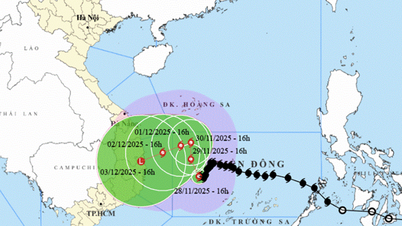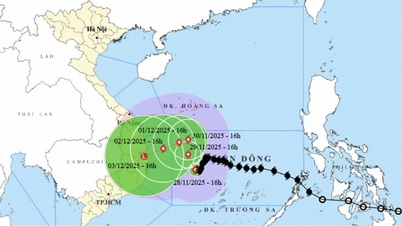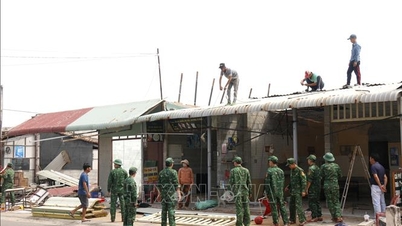On the afternoon of November 26, Mr. Hoang Phuc Lam, Deputy Director of the National Center for Hydro-Meteorological Forecasting (Department of Hydro-Meteorology, Ministry of Agriculture and Environment ) gave the latest assessment on the forecast of movement direction, intensity and impact of storm No. 15 on our country.
Reasons why storms weaken when approaching land
According to Mr. Lam, by 4 p.m. on November 26, storm Koto was at level 10 and likely to strengthen to level 11. Currently, under the influence of subtropical high pressure, the storm is moving quite steadily in the west-northwest direction, at a speed of about 20-25 km/h.
However, as the storm gradually moves away from the subtropical high pressure area, its movement will slow down. Notably, on the night of November 27, there will be a cold front, which is an unfavorable factor for the development of the storm. Initially, the storm will maintain its strong intensity, but then encounter cold seas and cold air penetrates deep into the storm's circulation, the storm's structure will be broken. This is the main reason why the storm will weaken significantly from the evening and night of November 29 onwards.

Mr. Hoang Phuc Lam, Deputy Director of the National Center for Hydro-Meteorological Forecasting (Department of Hydro-Meteorology, Ministry of Agriculture and Environment) commented on storm No. 15. Photo: Trung Nguyen.
The storm is forecast to decrease to level 9-10 on November 30 and December 1. Another point worth noting is that when moving to the area, when reaching the northwest sea of Truong Sa special zone (about 500km east of the Gia Lai - Khanh Hoa coast), the storm's trajectory tends to gradually shift north. This will change the impact of storm No. 15 on the sea areas as well as the mainland of Vietnam.
Currently, the hydrometeorological agency has proposed two scenarios. The scenario with the highest probability of occurrence (80%): The storm changes direction to the north and gradually weakens into a low pressure area. After that, this low pressure area is likely to drift towards the mainland of the central provinces and then weaken at sea. With this scenario, from November 27, the central East Sea area (including the sea area north of Truong Sa special zone) is likely to be affected by strong winds of level 10-11, gusts of level 14, waves of 6-8m high, and rough seas.
There is little chance of storms on land. The area from Da Nang to Lam Dong is likely to experience widespread heavy rain in the first days of December 2025, focusing on coastal areas and the rain is likely not as extreme as the recent rains of November 16-21.

The National Center for Hydro-Meteorological Forecasting's forecast bulletin, based on the scenario with the highest probability of occurrence, the storm changed direction and moved along the coastal areas of the South Central provinces. Photo: NCHMF.
The worst case scenario is that the storm does not change direction and enters the Gia Lai - Khanh Hoa area (20% probability). With this scenario, the storm can cause strong winds above level 6 right on the mainland, coastal areas from Da Nang to Lam Dong will have strong winds of level 8, gusting to level 10 from November 29. Waves will be 3-5m high, with rough seas. Rainfall can reach 150-250mm between November 29 and December 1, and the possibility of rain is not extreme.
However, because this area has experienced prolonged heavy rain and flooding, even a small downpour can trigger landslides. Therefore, localities need to comply with the direction of the National Civil Defense Steering Committee and guide communes/wards to deploy specific disaster preparedness measures.
“The National Center for Hydro-Meteorological Forecasting will continue to closely monitor the storm's developments as well as factors influencing its trajectory and intensity to provide full and timely updates in the next bulletins. It can be affirmed that the coastal and marine areas will certainly be affected. Vessels operating in this area are advised to proactively move out of the danger zone and seek safe shelter on land to avoid risks caused by strong winds of level 6 or higher,” Mr. Lam emphasized.
The storm's impact lasts a long time.
Explaining the reason why the forecast agency said the rain was not extreme, Mr. Lam said: For the Central region, the main factor causing rain is the terrain, with the Truong Son range stretching northwest - southeast acting as a "wall" to block the wind. Particularly with storm No. 15, the terrain area where the storm is expected to make landfall in the South Central region is not an area with high terrain to block the wind like the North Central region. The storm is strong mainly offshore, so the impact of the storm in the South Central region will be much smaller than in the case of an area near the center of the storm or directly hit by the storm.
A notable feature of storm No. 15, according to Mr. Lam, is the prolonged impact due to the slow movement of the storm. While many storms in 2025 move very quickly, at a speed of 25-30 km/h, reaching the mainland after only 2 to 3 days and gradually dissipating, storm Koto has a clear tendency to slow down.
It is expected that from the afternoon of November 28 onwards, the storm will move mainly at a speed of about 5-10 km/h. Therefore, the duration of the storm as well as the time to monitor and respond to this storm will extend into early December.
Regarding the longer term trend, from now until the end of December, there is still a possibility of another tropical depression or storm appearing in the East Sea. That shows that this year's storm season has not really ended, even after storm No. 15, we still need to continue to monitor closely.
As a general rule, storms occurring in November and December tend to have more impact on the South Central and Southern regions. Therefore, it is not impossible that storms after storm No. 15, if they do occur, will still mainly impact these two regions.
Including Typhoon Koto, the total number of tropical cyclones in the year has reached 20, including 15 storms and 5 tropical depressions, significantly higher than the average of many years. With the forecast of the possibility of storms/tropical depressions still appearing in the coming month, 2025 could become the year with the highest number of tropical cyclones in the past 30 years.
Source: https://nongnghiepmoitruong.vn/kich-ban-bao-so-15-tac-dong-den-dat-lien-d786697.html










































































































Comment (0)